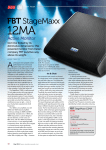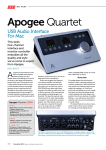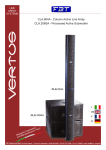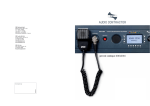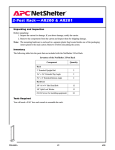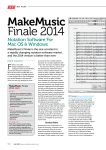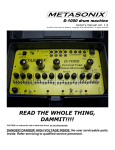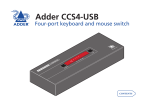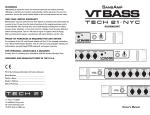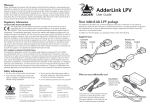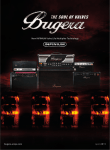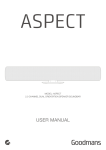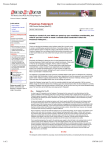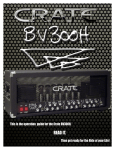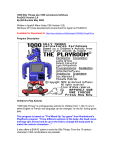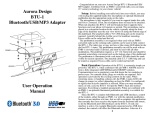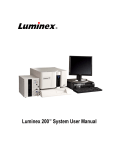Download first full UK review of the VERTUS
Transcript
on test FBT Vertus CLA 604A & CLA 208SA Compact Line Array Need a compact and discreet PA that still delivers quality sound? Then the FBT Vertus might just be for you... M i k e C r o ft s T he FBT Vertus is a compact, self-powered sound system comprising two components: the CLA 604A vertical line array and the CLA 208SA subwoofer. Various combinations of these two modules can be configured to produce systems suitable for a range of different applications. The Vertus system has been designed to be easily portable, and very simple to set up and operate. Let’s have a closer look at the ‘top’ part of the system. The CLA 604A is a vertical speaker array consisting of six four-inch drivers plus four one-inch, waveguide-mounted, neodymium-dome tweeters. The integral Class-D amplifier section (which incorporates all the necessary DSP and speaker protection) is continuously rated at 350W RMS for the LF/MF section, and 80W RMS for the HF above the crossover frequency, which is 2.5kHz. The relatively high crossover point means that much of the important vocal spectrum falls within the remit of the LF/MF section, and as such removes any crossover region issues from the critical mid-range. The overall FBT Vertus CLA 6040A £722 & CLA 208SA £633 pros • Attractive design and very well made. • Clear sound with very even coverage. • Compact, light, and easy to transport and operate. • Versatile. cons • Nothing comes to mind. frequency range of the CLA 604A is 130Hz to 20kHz (-6dB), with all the ‘real’ low-frequency material being handled by the associated subwoofer, more of which in a moment. The dispersion characteristics of a vertical array result in a wide horizontal coverage, with the output being restricted in the vertical plane. The CLA 604A achieves a nice and wide 100-degree horizontal pattern with only 20 degrees vertical. More acoustic energy is therefore directed towards the intended coverage area, rather than into the floor or ceiling/sky, giving the 604A the ability to project intelligible audio over longer distances than conventionally arranged ‘point-source’ speakers can. Physically speaking, the CLA 604A is just over 33 inches tall and five inches wide and deep (841 x 130 x 130mm, HxWxD), and is agreeably lightweight, at just 9kg (a shade under 20lb in old money). The cabinet is manufactured from extruded aluminium with a discreet, dark-grey, powder-coated finish, and it has a full-face metal grille. The entire assembly gives an impression of impeccable build quality and strength, and is simple and elegant in appearance. The 604A is designed to be used singly or in multiples, and can be hard-coupled end-to-end to produce a taller array for larger events. On the bottom of the enclosure, there’s a substantial connecting socket (mechanical, not electrical), with an inset rubber pad, to ensure a secure and vibration-free fit either to the next unit or to a pole stand. An easy-to-use locking pin arrangement holds the unit firmly in place, and this has five locating holes which provide a choice of horizontal ‘aiming’ angles. The pin itself is quite small but, like everything else about the CLA 604A, is very nicely engineered and has a good, reassuringly positive action. Panel Show summary A compact, stylish and solidly built column-style PA system that’s easy to use and provides quality sound. 86 At the top and bottom of the rear panel, there are deep recesses that house the signal and mains November 2012 / w w w . s o u n d o n s o u n d . c o m power connectors. Those at the bottom are inputs and the ones at the top are outputs, for connecting through to another CLA 604A if required. The power inlets are the Neutrik Powercon type and, as is common on self-powered array boxes, they also act as the power on/off switch, by simply turning them to their lock (on) or release (off) positions. As the connections are made within the recessed panels, the rest of the control panel is uncluttered and straightforward. Two rotary controls provide input level adjustment (fully anti-clockwise is effectively ‘no signal’) and a choice of four fixed EQ choices. These are specific settings to be used depending on which array configuration is being used (ie. one, two or three CLA 604A units). As the units have the same coupling hardware on each end, they can be joined together with the horns spaced (all the boxes the right way up, for closer target coverage), or with one of the boxes upside-down, so that the horns are adjacent, which will alter the dispersion characteristics, making the HF pattern somewhat wider and shallower. When a single satellite configuration is used, there is a choice of two EQ presets: The ‘1SAT Vertical Constant Release’ setting applies some sort of frequency shading to the woofers in the column, in order to achieve more uniform dispersion across a wider band. You can clearly hear this if you put your ear against the column and move up and down; three of the woofers are delivering a different output to the other three. The other single-column setting is marked ‘Max SPL’, and this applies the same material to all six drivers, for increased output. Input sensitivity of the CLA 604A can be switched between mic and line, the former being useful for speech-only applications where nothing but a microphone is required to make up a complete system. The selector itself is a simple push button, and, of course, care should be taken not to accidentally engage the mic setting when using a linelevel input. The user manual issues a dire warning on the subject: “Avoid sending a line signal (through mixer, etc.) while the Sources switch is positioned in Mic; failure to comply with this warning may cause damage Alternatives The most obvious competitors to the Vertus come in the form of the Bose L1 system, LD Systems’ Maui 28, the Fohnn LX100, K-Array Blueline KB1 and HK Audio Elements. or complete failure of speakers, woofer, high-frequency driver and internal power amplifiers.” ‘Nuff said! With usable low-frequency performance down to 130Hz, the CLA 604A can be used as a stand-alone system, but to realise its full potential it should be used in conjunction with an external subwoofer. A low-cut filter switch is provided on the input, which means that a full-range input can be connected to the 604A if, for example, the external sub doesn’t have a filtered output. Having said that, the partner sub of choice is almost always going to be the one it’s designed to work with, namely the Vertus CLA 208SA... Eights Of Bass The 208SA is a powered, 400W RMS subwoofer with twin eight-inch drivers housed in a very low-profile reflex enclosure. It’s an extremely compact piece of kit, w w w . s o u n d o n s o u n d . c o m / November 2012 87 on test FBT Vertus CLA 604A & CLA 208S and the black birch-ply cabinet and thick steel grille give it a purposeful but discreet appearance. The CLA 208SA is designed to act as a base support for the CLA 604A array, and is equipped with a good metal-screw pole-mount on top. There is also the option of mounting multiple top columns to a steel plate on the front of the sub, via three fixing pins. Stereo XLR inputs are summed and sent to the internal amp, and a choice of direct link or high-pass filtered outputs is provided, together with the ability to switch input polarity. Like the CLA 604A, there are input level and EQ knobs, but this time the four EQ settings offer options for the sub’s upper cutoff frequency (either 120Hz or 180Hz), and also ‘original’ or ‘punch’ curves for each option. The ‘original’ EQ is what I regarded as the default setting, with the subwoofer operating across its full range. The ‘punch’ EQ provides more output in the middle of the range, giving a nice thumpy kick, but with some loss of the very low-end output. Assembly The Vertus system can be configured in various ways, including stacking the two subs together for more bass output, or assembling the whole thing as one unit when the sound source can be in a single location, for example a single instrument on stage or a mono AV presentation. Putting it all together is as easy as falling off a plank: the quality of the mounting hardware is excellent, and it all clicks together smoothly. A single power feed can be used for each stack, courtesy of the in/out Powercon connectors, meaning that the system looks neat and tidy with minimum cabling (if the cables linking the The CLA 604A’s rear-panel controls comprise a volume knob, a mic/line switch, a rotary control for selecting one of four array presets, and a high-pass filter switch for the link output XLR. 88 sub and the array unit are taped to the poles, they are almost completely invisible from the front). I’d say it takes about a minute to physically assemble a single CLA 604A on a pole above a CLA 208SA, then all you have to do is plug in the power and signal leads and it’s up and running. In The Real World When I first listened to the Vertus system in the workshop, it sounded clear and clean, with plenty of bass from the two subs in the review system. In a relatively confined space and at low level, I could hear the difference when trying different EQ presets, but not to any great extent, so I took the whole thing outside and set it up in the car park. Listening from more of a distance, I used the two single-satellite presets and found them both perfectly smooth-sounding with a variety of recorded material and test recordings. The Max SPL setting does seem subjectively louder, but to be honest I liked the original setting just as much at higher levels, and the sound remained well balanced some 20 yards back. I took the Vertus rig out on two live gigs — one only needed voice reinforcement in a school hall, and the other was an outdoor jazz event where we were miking up the whole band. I stayed with the ‘normal’ EQ settings on both the CLA 208SA and the CLA 604A, with very satisfactory results, and the performers and organisers both commented on how neat the Vertus system looked and how much they liked the sound. There was plenty of good, clean upright bass and kick drum, a bright piano sound (from a Nord Stage), smooth but crisp sax and, most importantly, smooth and warm vocals throughout the session. One point of interest was the apparent sharp HF cutoff at the horizontal dispersion limit. In the workshop and the school hall, this was not noticeable because of the close reflective surfaces, and it was possible to walk right around each of the CLA 604As without much change in sound, whereas in the open space, the more pronounced cutoff was very helpful in avoiding feedback from the mics, even though they were more or less level with the speakers. Feedback shouldn’t really be a problem with this type of driver layout, and later I did some checks back at base by using a cheap dynamic mic right in front of the CLA 604A, achieving a reasonable level before the onset of ringing. The last, and probably most fun, test I carried out was to connect it up to an electronic organ keyboard in a local church November 2012 / w w w . s o u n d o n s o u n d . c o m The CLA 208SA’s inputs are present on ‘combi’ XLR/jack sockets, and the sub has both full-range and high-pass filtered output XLRs. Four EQ presets are available, as is a polarity-invert option. in place of the installed system (light oak cabinet, gold weave cloth behind some slits, you know the sort of thing) and got someone to thunder out a few hymns and other organy material. The sound was what I can only describe as ‘alive’, and it absolutely filled the building (and the streets either side) with sound. Summing Up The FBT Vertus is undoubtedly a visually appealing sound system, with impressive build quality and finish. It would fit in very nicely where the PA has to be heard and not seen, where there is a restricted amount of space, or where you want slim and sexy-looking speakers. The Vertus system delivers a bigger sound than you’d expect from its compact design. If you’re used to operating with traditional two-way 15-inch or 12-inch cabinets, it will take a bit of getting used to, but the sound quality comes through, and for small to medium-sized venues where clarity and wide, even coverage are important, this is a serious contender that should win many friends. ££ CLA 604A £722; CLA 208SA £633. Prices are per speaker, including VAT. TT FBT UK +44 (0)8443 104592. EE [email protected] WW www.fbtaudio.co.uk Mix with the best! “Besides the excellent interviews and fascinating, in‑depth recording and mixing articles, I can always depend on Sound On Sound for complete, unbiased reviews of the latest pro‑audio gear. “ Bob Clearmountain, engineer, producer and mixer, Grammy Award winner (Bruce Springsteen, The Rolling Stones, Paul McCartney, INXS) “As a professional I admire Sound On Sound as one of the most trusted and credible sources of inspiration and information.” Jack Joseph Puig, mixer, producer, Grammy Award winner (Rolling Stones, U2, Mary J Blige, Black Eyed Peas) The World’s Best Recording Technology Magazine This article was originally published in Sound On Sound magazine, November 2012 edition follow us on Twitter find us on Facebook go to the SOS YouTube channel visit the SOS forum Subscribe and Save Money! Visit our subscriptions page at www.soundonsound.com/subscribe for more information on the Sound On Sound App go to: www.soundonsound.com/app Sound On Sound, Media House, Trafalgar Way, Bar Hill, Cambridge, CB23 8SQ, United Kingdom Email: [email protected] Tel: +44 (0) 1954 789888 Fax: +44 (0) 1954 789895 All contents copyright © SOS Publications Group and/or its licensors, 1985-2012. All rights reserved. The contents of this article are subject to worldwide copyright protection and reproduction in whole or part, whether mechanical or electronic, is expressly forbidden without the prior written consent of the Publishers. Great care has been taken to ensure accuracy in the preparation of this article but neither Sound On Sound Limited nor the publishers can be held responsible for its contents. The views expressed are those of the contributors and not necessarily those of the publishers.




